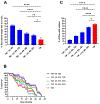Vitamin B5, a coenzyme A precursor, rescues TANGO2 deficiency disease-associated defects in Drosophila and human cells
- PMID: 36502486
- PMCID: PMC10464931
- DOI: 10.1002/jimd.12579
Vitamin B5, a coenzyme A precursor, rescues TANGO2 deficiency disease-associated defects in Drosophila and human cells
Abstract
Mutations in the Transport and Golgi Organization 2 (TANGO2) gene are associated with intellectual deficit, neurodevelopmental delay and regression. Individuals can also present with an acute metabolic crisis that includes rhabdomyolysis, cardiomyopathy, and cardiac arrhythmias, the latter of which are potentially lethal. While preventing metabolic crises has the potential to reduce mortality, no treatments currently exist for this condition. The function of TANGO2 remains unknown but is suspected to be involved in some aspect of lipid metabolism. Here, we describe a model of TANGO2-related disease in the fruit fly Drosophila melanogaster that recapitulates crucial disease traits. Pairing a new fly model with human cells, we examined the effects of vitamin B5, a coenzyme A (CoA) precursor, on alleviating the cellular and organismal defects associated with TANGO2 deficiency. We demonstrate that vitamin B5 specifically improves multiple defects associated with TANGO2 loss-of-function in Drosophila and rescues membrane trafficking defects in human cells. We also observed a partial rescue of one of the fly defects by vitamin B3, though to a lesser extent than vitamin B5. Our data suggest that a B complex supplement containing vitamin B5/pantothenate may have therapeutic benefits in individuals with TANGO2-deficiency disease. Possible mechanisms for the rescue are discussed that may include restoration of lipid homeostasis.
Keywords: Drosophila; TANGO2; coenzyme A; membrane traffic; metabolic crisis; neurodevelopment; vitamin B5.
© 2022 SSIEM.
Conflict of interest statement
Figures




References
-
- Bard F, Casano L, Mallabiabarrena A, et al. Functional genomics reveals genes involved in protein secretion and Golgi organization. Nature 2006;439:604–607. - PubMed
-
- Schymick J, Leahy P, Cowan T, et al. Variable clinical severity in TANGO2 deficiency: Case series and literature review. Am J Med Genet A 2022;188:473–487. - PubMed
Publication types
MeSH terms
Substances
Grants and funding
LinkOut - more resources
Full Text Sources
Other Literature Sources
Molecular Biology Databases

